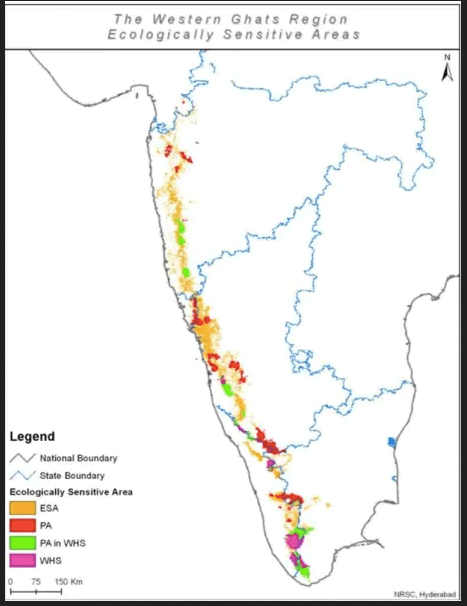UPSC Articles
ENVIRONMENT/ GOVERNANCE
- GS-3: Conservation, environmental pollution and degradation
- GS-2: Government policies and interventions for development in various sectors and issues arising out of their design and implementation.
Kasturirangan Committee in Western Ghats
In News: On December 4, Karnataka Chief Minister informed the Centre that the state is opposed to the Kasturirangan Committee report on Western Ghats.
- He said that declaring Western Ghats as ecologically sensitive zone would adversely affect the livelihood of people in the region.
- However, the experts called the state’s opposition disastrous for the ecologically fragile Western Ghats.
What are the recommendations of the Kasturirangan committee report?
- The Kasturirangan committee report proposes 37 per cent of the total area of Western Ghats, which is roughly 60,000 square kilometres, to be declared as eco-sensitive area (ESA).
- Out of this, 20,668 sq km of the area falls in Karnataka covering 1,576 villages. T
- The report recommended a blanket ban on mining, quarrying, setting up of red category industries and thermal power projects.
- It also stated that the impact of infrastructural projects on the forest and wildlife should be studied before permission is given for these activities.
- It also stated that the UNESCO Heritage tag is an opportunity to build global and domestic recognition of the enormous natural wealth that exists in the Western Ghats.
- The 39 sites are located across the Western Ghats and distributed across the states (Kerala 19), Karnataka (10), Tamil Nadu (6) and Maharashtra (4).
- The boundary of the sites, are in most cases, boundaries of the legally demarcated national parks, wildlife sanctuaries, tiger reserves and forest divisions and therefore, already accorded with high level of protection.
- The Eco-Sensitive Area mapping and demarcation done by the committee also indicates that all sites are within this area.
- The state governments should view this development and build a plan to protect, conserve and value the resources and opportunities of the region.
- The state of Karnataka has the highest percentage of the ESA- 46.50 per cent.

Why have the successive governments in Karnataka rejected the report?
- The state government believes that implementation of the report will halt the developmental activities in the region.
- The government has stated that Karnataka has the distinction of being one of the states with extensive forest cover and the government has taken care to protect the biodiversity of Western Ghats.
The Kasturirangan report has been prepared based on the satellite images, but the ground reality is different. People of the region have adopted agriculture and horticultural activities in an eco-friendly manner.
- Priority has been accorded for environment protection under the Forest Protection Act. In this background bringing one more law that would affect the livelihood of the local people is not appropriate.
- The union government since 2014 has issued several draft notifications to the Karnataka government to finalise the eco-sensitive areas in the Western Ghats but the government has been firm in rejecting the implementation of the report.
What impact will the non-implementation of the report have on the Western Ghats?
- Considering the changes in climate (evident from recurring floods, droughts, landslides, increasing temperature, etc), which would affect the livelihood of all people (irrespective of poor or rich) and hurt the nation’s economy, it is prudent to conserve the fragile ecosystems.
- Experts suggests the government to accept and implement the report.
- World are in the throes of extreme climate events, which are impacting nature and people. Yet, the government continues to object valued suggestions of acclaimed researchers.
- If the government truly cares for the welfare of 22 crore people who are sustained by the Western Ghats, it would accept at least 85 per cent of the recommendations of the Kasturirangan Committee. Else, it would be the reason for the sufferings of the people.
What is the present status of the deemed forest land in Karnataka?
- While there is a growing concern over the forest encroachments in Karnataka, the state government has planned to further shrink the deemed forest area from 3,30,186.938 hectares to 2 lakh hectares.
- In the order dated December 12, 1996 of the Supreme Court of India in Writ Petition in Godavarman Thirumulpad Vs Union of India & others, the term forest as per dictionary meaning and the forests recorded in government records were to be included in the broad definition of ‘forests’ along with notified forests for consideration of any diversion proposal under the Forest (Conservation) Act, 1980.
- The state expert committee in 1997 had identified 10 lakh hectares of deemed forest area which over the years were shrunk by the successive governments.
Connecting the dots:
- Environment Impact Assessment(EIA)
- Sustainable Development Goals













